Kokuren Forum Jordan Study Program (2019) Activity Report
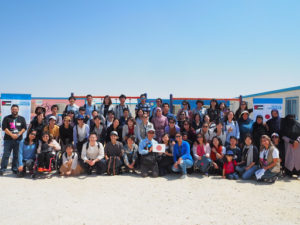
Executive Summary
This document is a shortened English version of an activity report in Japanese of the 2019 Kokuren Forum Study Program to Jordan, in which 57 Japanese youths explored the history and current situation of the refugees in Jordan as well as the possible paths for the country’s sustainable development. The first section of this report summarizes the purposes and format of the annual Kokuren Forum Study Program. The second section provides a description of the Jordan Study Program, including the preparatory phase starting in May 2019, a field trip in the summer, and the post-trip activities until March 2020. While the field trip to Jordan was the highlight of the Program, the pre- and post-trip activities also constituted a crucial part for the participants’ thorough understanding of the circumstances and challenges facing Jordan. Finally, the report ends with brief reflection pieces by four participants who describe their experiences and key learnings from joining this Project.
Introduction
1. What is Kokuren Forum?
Kokuren Forum, established in 2004 in Japan, is a network of over 8,000 professionals and students who are interested in enhancing their understanding of evolving global issues and associated work undertaken by the UN Systems. ‘Kokuren’ is the abbreviation of “the United Nations” in Japanese.
Kokuren Forum serves as a key knowledge hub in Japan for;
1) enhancing the understanding of a diverse range of global issues that interact towards sustainable development, and
2) promoting the work of the UN systems by disseminating snapshots of ongoing activities and achievements in various thematic areas and regions where the UN systems operate.
It also regularly organizes study sessions and brown-bag lunches in, inter alia, New York, Washington D.C., and Tokyo.
2. What is Kokuren Forum Study Program and Jordan Study Program?
Kokuren Forum annually conducts a short study program abroad to provide interested individuals with an opportunity for gaining insights into the UN operations in developing countries. It is a unique, self-built program where all participants contribute to its development and implementation, from conducting research on relevant organizations and projects for site-visits, developing specific learning objectives, planning, scheduling, to compiling reports and disseminating learning outcomes afterwards.
The Kokuren Forum Study Program, started in 2010, has taken place in Timor-Leste (2010), Thailand (2011), Cambodia (2012), Mongolia (2013), Myanmar (2014), Sri Lanka (2015), Nepal (2016), Rwanda (2017) and Papua New Guinea (2018).
Kokuren Forum Jordan Study Program (hereafter, JSP) in 2019 explored the nexus between conflict and coexistence in the Middle East context. Using Jordan as a case study, JSP participants visited several organizations that aimed at gaining an in-depth knowledge of the interplay between sustainable development and protection agenda for refugees, asylum seekers and displaced people. Through the experience of collectively building this study program, participants have enhanced their leadership skills and self-confidence, and became self-disciplined and independent-minded.
This report compiles the learning outcomes from the seven-day country visit from 15 to 21 September 2019, and it will be disseminated through the Kokuren Forum network. Through this report, JSP participants express their gratitude for all organizations that supported our program by showing what we learned and how we “changed” in the JSP’s process. Besides, we hope that those who read this report become interested in a Study Program and become future participants.
Overview of Jordan Study Program (JSP)
1. About JSP
Objectives:
- Learning: The participants studied Jordan’s sustainable development in view of several fields such as politics, economics, cultures, history, education, health, environment and gender. They particularly focused on the protection of refugees, asylum seekers, and displaced people in Jordan. The participants not only studied factual information, but also discussed some potential ways to improve the living conditions of refugees, promote the nation’s sustainable development, and enable coexistence of different social groups in Jordan.
- Experience: The participants visited project sites and refugee camps, met international and local actors, including the host communities, and interviewed them to acquire first-hand information.
- Capacity-Building: Each participant contributed to the planning and implementation of the whole program. Throughout the activities, participants had opportunities to acquire leadership, team-building skills and self-reliance.
Dates of the field visit: 15 – 21 September, 2019 (seven days)
Number of members: 57 (51 members participated in the field visit)
Appointments of the site visits:
The destination of the field visit was determined in close consultation with the local representatives of UN organizations, NGOs and other organizations. The number of participants for each appointment was decided following advice received from the respective organizations.
In order to achieve three stated objectives, JSP was designed to include the following three steps:1) meticulous research and planning for the visit to Jordan, 2) field visit to Jordan, and 3) post-visit activities. Throughout the program, the participants tried to combine secondary information acquired from books and online sources with the first-hand knowledge they gained from the field visit. Another distinguishing feature of this program was, under the concept of ‘full participation’, participants themselves took part in the learning processes, including the planning of pre-visit study sessions.
2. Planning for the visit
The members belonged to the following five groups to conduct the preparation effectively and smoothly.
The Program Planning Team was in charge of building the schedule during the stay in Jordan from scratch. It contacted various organizations based in Jordan to arrange meetings. It also arranged the necessary logistics for the participants’ safe and comfortable travel and smooth implementation of all programs in Jordan.
The Research Team organized four preparatory study sessions where members learned and discussed critical socio-political issues in Jordan and the specific activities of organizations they would visit.
The Public Relations Team was in charge of sharing information about the participants’ learning process, in order to raise awareness of the Program and issues surrounding Jordan.
The Risk Management Team was in charge of ensuring the safety of the participants during the visit to Jordan through careful examination of risk factors and frequent meetings before and during the stay in Jordan. The team was also responsible for overseeing each member’s health condition in Jordan.
The Accounting Team undertook financial management of JSP.
The Innovation Team was responsible for the ideation and implementation of new initiatives that have never been attempted before in the previous Study Programs. Examples include the utilization of a VR camera in Jordan, development of new external connections and lectures for university and junior high school students in Japan.
Actively participating in preparation for the field visit allowed the members to acquire sufficient background knowledge about Jordan and its challenges, identify key questions and hypotheses, and take ownership in creating the rest of the program.
3. Visit to Jordan
During the one-week stay in Jordan, JSP participants were divided into several groups and visited various governmental and non-governmental organizations listed in the chart below. In each visit, the participants received a briefing from the organization staff and engaged in a fruitful discussion with them. Most of the organizations also offered an opportunity for a site visit, in which the participants could witness actual project implementation.
|
Date |
Organizations |
|
15 Sep |
Ministry of Planning and International Cooperation(MoPIC) / Jordan River Foundation (JRF), UN Women, International Committee of Red Cross (ICRC), United Nations Development Programme (UNDP), UN-Habitat, World vision, International Organization of Migration (IOM), World Bank Youth Advisory Group |
|
16 Sep |
United Nations Relief and World Agency for Palestinian Refugees (UNRWA), UNDP, United Nations Children’s Fund (UNICEF), World Bank, UN-Habitat, Japan International Cooperation Agency (JICA) |
|
17 Sep |
World Food Programme (WFP) (Azraq camp), ICT Association, International Labour Organization, Ruwwad, World Health Organization (WHO) |
|
18 Sep |
UNRWA(Baqa’a camp), UNRWA(Amman New camp), Teenah, Tribalogy, Norwegian Refugee Council (NRC) |
|
19 Sep |
United Nations High Commissioner for Refugees (UNHCR) / WFP / UNICEF / UN Women/United Nations Population Fund (UNFPA) (Zaatari camp), UNDP in Ma’an, Danish Refugee Council (DRC) in Karak |
4. Post Visit Activities
After the visit to Jordan, the participants kept on deepening their thoughts and knowledge which they had cultivated through the experiences in Jordan. They also reported on their field learning to a wider audience in the following ways.
First, they organized four public reporting seminars in Hokkaido, Fukuoka, Osaka, and Tokyo from December from 2019 to March 2020. These sessions aimed at sharing with the general public the experiences and major findings of the Program participants and providing relevant information about Jordan and critical issues the country faced as well as the activities of key international organizations that the participants visited in Jordan. Also, they had a presentation on “Prolonged refugee issues in Jordan and a perspective of Human Security” in front of about 150 audiences in the bi-annual ‘Networking Conference’ of Kokuren Forum.
Second, they had a privilege to give a special lecture 1) for about 10 students at Kwansei Gakuin University on how to successfully prepare and conduct fieldwork and 2) for about 50 students at Toin junior high school discussing general refugee issues.
Finally, the participants published the final report in Japanese and English which included the activities and voices of JSP members.
All JSP participants are convinced of a significant amount of support and kindness of all the organizations which kindly took time and effort to support the Program throughout, in particular in arranging the in-country site visits.
Voices of Project Participants
1. Martin Kunito
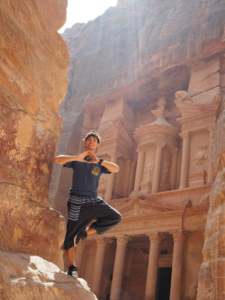 I am Martin, and I work at a manufacturing company in Tokyo. I decided to participate in JSP to learn about the current situation of refugees in Jordan. Working in Tokyo, I increasingly felt that Japanese society is extremely detached from the refugee problem. That is why I wanted to see the actual situation in Jordan and think about what we can do from Japan.
I am Martin, and I work at a manufacturing company in Tokyo. I decided to participate in JSP to learn about the current situation of refugees in Jordan. Working in Tokyo, I increasingly felt that Japanese society is extremely detached from the refugee problem. That is why I wanted to see the actual situation in Jordan and think about what we can do from Japan.
During the visit in Jordan, I was able to visit three refugee camps: Zaatari Camp, Azraq Camp, and Amman New Camp. Each camp had different characteristics, and I had the opportunity to see many projects led by international organizations and NGOs working there.
First, I visited Zaatari Camp which was established in 2012, immediately after the Syrian crisis had broken out. Even today, about 80,000 people live in this densely populated area. There are 16 schools in Zaatari Camp, and most of them employ a double-shift system in which girls are taught in the morning and boys in the afternoon. Yet, only about 50% of refugee children are able to attend school. In spite of the significant efforts made by organizations such as UNICEF and UNHCR, the education system remains seriously under-resourced. In terms of the cultural life in Zaatari camp, the most impressive feature was an avenue called “Champs Elysee,” where Syrian refugees independently ran many shops. The avenue had a very lively and bustling atmosphere and seemed to serve as a social hub within the camp.
Next, I visited Azraq Camp which opened in 2014. With streets laid out in a grid, Azraq Camp was more deliberately structured than Zaatari camp, and was designed to accommodate a maximum of 100,000 people. At present, the camp hosts approximately 40,000 refugees. The camp was vast with wide spacing between each house. Though this may ensure the privacy of each household, it also gave a quiet and lonely impression, which was in stark contrast with the more chaotic yet warm atmosphere of Zaatari Camp. Azraq Camp was the first refugee camp to employ iris scan and blockchain technology in its management of the refugees. Refugees receive 32 USD per month for grocery shopping, and they make the payments via scanning their irises at the cashier. There were two big WFP-run supermarkets in the camp, and I saw a lot of people buying food by using this iris scan system. I thought this system to be especially beneficial to women—who may not possess as much social power as men—for it guarantees their ability to use the money themselves and eliminates the risk of their money getting stolen or robbed.
Finally, I visited Amman New Camp (ANC) which was constructed in 1955 after the Arab-Israeli War in 1948. About 57,000 Palestinian refugees live there. ANC was very different compared to the two Syrian refugee camps. Unlike the geographically isolated Syrian refugee camps, ANC blended into the surrounding city so smoothly that I did not even realize I had entered the refugee camp. Public buildings, such as schools and health centers, were bigger and more solid. However, upon speaking with people, I was reminded that I was in a refugee camp, for everyone strongly expressed their hope to return to their homeland, as well as their pride in the Palestinian identity. This sentiment made it clear that despite the camp’s appearance as any other part of the city, it is understood as a temporary home by its refugee residents.
Each refugee camp had very different structures and features, and I learned that we cannot lump them together under one umbrella concept of “refugee camp.” One commonality among the three camps, however, was the refugees’ hope to return to their homelands one day. While many international organizations and NGOs operate in the refugee camps, these supports are only temporary. Through this trip, I realized that we must resolve and prevent the root cause. I believe that more international attention to and awareness of the present refugee situation in Jordan and its complexities has potential to create a positive impact moving forward. This is why I hope to raise Japanese people’s awareness of this important issue.
I would like to share with my Japanese friends what I saw, heard, and learned in Jordan, and I hope to bring this problem a little bit closer to them.
2. Yusuke Ikeda
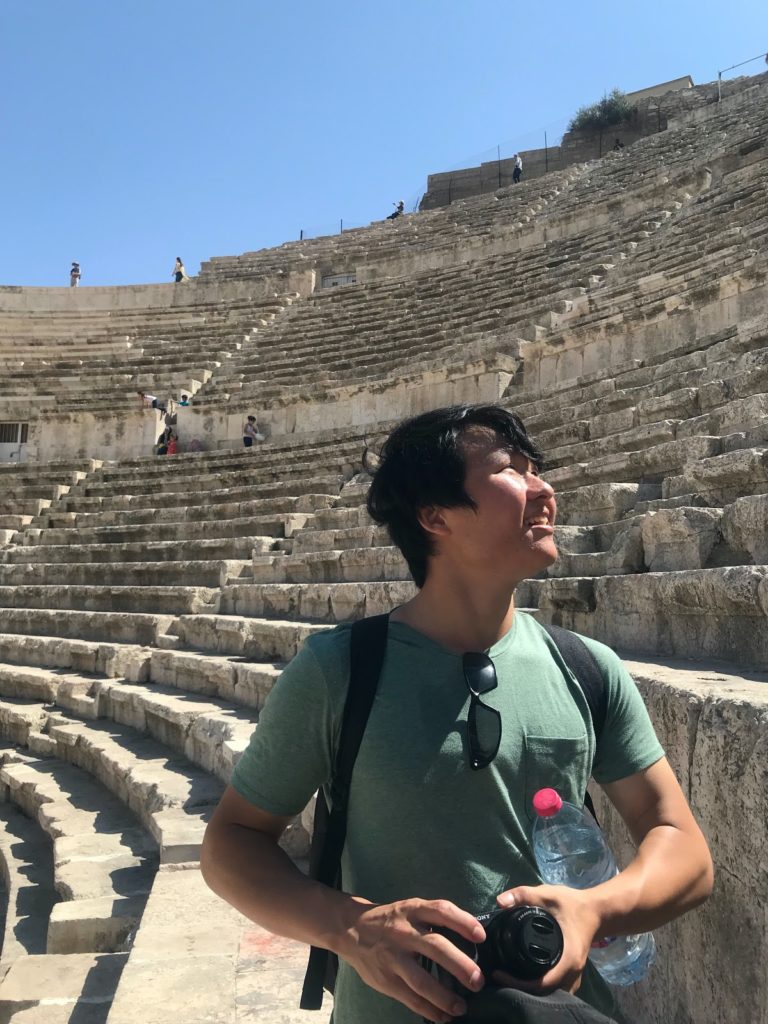 I am Yusuke, a medical student at Kyoto University. I am interested in public health, especially in the inequality of access to healthcare. Public health is not only about medicine, but it involves various elements such as education, economy and culture. Professionals in the field of public health need to collaborate with people in different fields and levels in order to solve complicated issues. However, I had almost no opportunities to know about other than medicine in my campus life. Thus, I decided to take part in JSP to learn different fields such as social, economical and social studies, which can be related to public health.
I am Yusuke, a medical student at Kyoto University. I am interested in public health, especially in the inequality of access to healthcare. Public health is not only about medicine, but it involves various elements such as education, economy and culture. Professionals in the field of public health need to collaborate with people in different fields and levels in order to solve complicated issues. However, I had almost no opportunities to know about other than medicine in my campus life. Thus, I decided to take part in JSP to learn different fields such as social, economical and social studies, which can be related to public health.
During the stay in Jordan, I spent a lot of time thinking about the difficulty of identity building of refugees. At Baqa’a camp for Palestinian refugees, we discussed with student council members. They were born in Jordan and had never been to Palestine. They received a high-quality education in Jordan and their current situation seemed to be relatively blessed. When we asked if they would think about continue staying in Jordan in the future, however, they replied immediately that they wanted to go back to Palestine. They were proud of being Palestinian and knew very well about the current situation of UNRWA, such as financial difficulties after the U.S. cut funding, though they were children. I thought it was because teachers at school and families at home repeatedly taught them about the Palestinian identity. Additionally, there are lots of situations outside of schools and home where they had to realize their identity. For example, the difference of employment sector between Palestinian and Transjordanian make them aware that they are different from Transjordanian.
Such identity-building circumstances are essential for the empowerment of Palestine. If young generations forget their national identity and wish to stay in Jordan, their return to Palestine will become more difficult. For Palestinians who want to go back to Palestine, they need to avoid such situation and identity-building is natural measure.
So far, however, the situation does not allow their return to Palestine. They may suffer from the gap between their ideal and the reality. Additionally, Palestinians have to co-exist with non-Palestinian people in Jordan. Building and maintaining a distinct Palestinian identity will make the Palestinians realize the differences between themselves and non-Palestinians in Jordan. This could become an obstruction to the co-existence and affect hardship of each of their lives in Jordan. I keenly felt the difficulty of balancing the good of group and the well-being of individuals.
3. Akitsu Takahashi
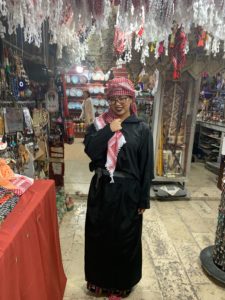 I am Akitsu from Osaka, Japan. I am a Political Science major focusing on development studies in an undergraduate program in Japan. My main academic interests are in the fields of conflict studies and peace building, specifically regarding the functions of both international organizations and national governments in conflict prevention. Jordan Study Program which aimed at exploring the nexus between conflict and coexistence in the Middle East was an appealing and intriguing opportunity for me, and it did not take a while before I decided to join.
I am Akitsu from Osaka, Japan. I am a Political Science major focusing on development studies in an undergraduate program in Japan. My main academic interests are in the fields of conflict studies and peace building, specifically regarding the functions of both international organizations and national governments in conflict prevention. Jordan Study Program which aimed at exploring the nexus between conflict and coexistence in the Middle East was an appealing and intriguing opportunity for me, and it did not take a while before I decided to join.
The preparatory research, presentations and discussions that I conducted with other members of JSP were productive and full of new learnings. This intensive preparation process made the visit to Jordan an even more fruitful and extraordinary experience. Here, I would like to write how I prepared for the visits to a number of international organizations, NGOs, and project sites in Jordan. I will highlight how the preparatory study sessions in Japan linked to my learning experiences at the actual site visits.
Before traveling to Jordan, JSP participants organized four study sessions to understand the multifaceted reality of the country and issues it faced, such as its history, diplomacy, development plan, environment issues, refugee acceptance and co-existence. They also studied how multitude of actors engage with all those events. Through those study sessions, what impressed me the most was how Jordan had survived in such a chaotic and complicated historical and political situation in the Middle East. Based on research, I realized that many of the organizations supporting the development of Jordan commonly included both incoming refugees and local Jordanians as their beneficiaries. It can be said that this inclusive development strategy with a long-term perspective has contributed to Jordan’s ability to maintain good relations with neighboring countries and conserve its tradition and culture.
I got a lot of inputs regarding the Jordan’s policies on refugee acceptance, its nation building and development during the stay in Jordan, which I still struggle to understand and link them with each other. Therefore, I am currently sorting the knowledge I gained throughout the program, telling my experience to people around me, and devising policy suggestions as a political science student. It was an honor for me to have surrounded myself with amazing people both in Jordan and in Japan. I am thankful from the bottom of my heart for such an opportunity.
4. Yuki Nakao
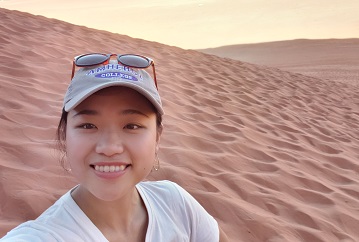
I am Yuki, a master’s student studying public policy at The University of Tokyo. My research areas include political theories, comparative politics, and feminist theories. I am particularly interested in the ways in which gender relations determine power distribution in a given community. My objective of joining JSP was in line with my academic interests. I wanted to learn what kind of women’s empowerment initiatives took place in Jordan and the extent of their efficacy in transforming gender relations in Jordanian society.
During my stay in Jordan, I learned about multiple women’s empowerment initiatives, all implemented by different agencies. Although I had initially hypothesized that the objectives and contents of women’s empowerment projects would substantially differ depending on the target social group, i.e., whether the women were Jordanians or refugees, I found striking commonalities among the projects.
First, most of the projects I witnessed in Jordan aimed at promoting women’s income generation. The “women’s market” at Azraq Refugee Camp, Teenah (tote-bag manufacturer that employs both Jordanian and refugee women), and Khoyoot (NGO promoting traditional Palestinian embroidery goods) all emphasized the importance of handing cash to women. The logic behind the emphasis on income generation was that financial capacity could be translated to power, autonomy, and freedom within families – when the wife brings food to the table, her husband respects and “grants” her larger freedom.
Second, women participating in these projects earned money with the skills they had already had or were easily attainable, such as embroidery, sewing, and soap making. Directors of Teenah and Khoyoot respectively explained that husbands were more likely to grant their wives permission to work when the means to earn income were within the boundaries of “women’s work.” These projects’ attempt to capitalize on the gender-based division of professions and skills, rather than being limited by it, was particularly revealing to me, because it represented the importance of setting priorities among various feminist causes. Deconstructing gender stereotypes regarding professions is an important feminist mission, but the projects I saw in Jordan clearly defined women’s financial independence as the most immediate, realistic, and effective strategy to transform the social relations between women and men in the given cultural context.
Finally, the women’s empowerment projects often had multiple purposes alongside women’s income generation. For instance, the “women’s market” in Azraq refugee camp provided a significant space for socialization and means to spend time in an otherwise Teenah aimed at promoting interactions and mutual understanding between Syrian refugee women and Jordanian women, as well as at replacing plastic bags with their cotton bags. Khoyoot’s embroidery products aimed at preserving Palestinian national culture in the face of long-standing refugeeism. In this sense, women’s empowerment projects are designed to kill two or more birds in one stone, rather than solely focusing on income generation.
The experience and lessons from visiting Jordan inspired me to learn more about local women’s empowerment initiatives, potentially with a comparative lens; how the efforts in Jordan may differ from those in other Arab countries or non-Arab countries. I would like to also know how income generation can be translated to political, social, and cultural empowerment of women. I would like to express my deepest appreciation to all of those who provided me with the precious opportunity.

